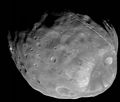Ta'ãnga:Phobos colour 2008.jpg

Tamaño de esta previsualización: 636 × 600 píxeles. Otras resoluciones: 255 × 240 píxeles | 509 × 480 píxeles | 815 × 768 píxeles | 1086 × 1024 píxeles | 2172 × 2048 píxeles | 3500 × 3300 píxeles.
Marandurenda moambue'ỹre (3500 × 3300 píxeles; tamaño de archivo: 2,72 MB; tipo MIME: image/jpeg)
Marandurenda rembiasakue
Ejopy peteĩ ára/aravo rehe rehecha hag̃ua pe marandurenda ojehechaukaháicha upe jave.
| Ára/Aravo | Michĩháicha | Tuichakue | Puruhára | Jehaimombyky | |
|---|---|---|---|---|---|
| ko’ag̃agua | 03:10 2 jasyrundy 2018 |  | 3500 × 3300 (2,72 MB) | Kaldari | more margin on right side |
| 04:47 13 jasypateĩ 2008 |  | 3374 × 3300 (2,7 MB) | Fir0002 | == Summary == {{Information |Description=Colour image of Phobos, imaged by the Mars Reconnaisance Orbiter in 2008 |Source=NASA |Date=9 April 2008 |Location=http://www.nasa.gov/mission_pages/MRO/multimedia/pia10368.html |Author=NASA/J |
Marandurenda jeporu
La siguiente página usa este archivo:
Marandurenda jepuru opaite tembiapópe
Ko'ã ambue wiki oipuru ko marandurenda:
- Jeporu af.wikipedia.org rehe
- Jeporu an.wikipedia.org rehe
- Jeporu ar.wikipedia.org rehe
- المريخ
- فوبوس
- قمرا المريخ
- ويكيبيديا:صور مختارة/الفضاء والكون/نظرة إلى الأعلى
- قائمة أجرام المجموعة الشمسية مرتبة حسب الحجم
- بوابة:علم الفلك/صورة مختارة
- بوابة:المريخ
- بوابة:المريخ/مقالة مختارة/أرشيف
- بوابة:المريخ/مقالة مختارة/2
- قائمة الأقمار الطبيعية
- خط زمني لاكتشاف كواكب المجموعة الشمسية وأقمارها
- ويكيبيديا:ترشيحات الصور المختارة/القمر فوبوس
- ويكيبيديا:صورة اليوم المختارة/أغسطس 2019
- قالب:صورة اليوم المختارة/2019-08-03
- بوابة:علم الفلك/صورة مختارة/73
- معسكر قاعدة المريخ
- ويكيبيديا:صورة اليوم المختارة/يناير 2022
- قالب:صورة اليوم المختارة/2022-01-04
- Jeporu ary.wikipedia.org rehe
- Jeporu arz.wikipedia.org rehe
- Jeporu as.wikipedia.org rehe
- Jeporu azb.wikipedia.org rehe
- Jeporu az.wikipedia.org rehe
- Jeporu be-tarask.wikipedia.org rehe
- Jeporu be.wikipedia.org rehe
- Jeporu bg.wikipedia.org rehe
- Jeporu bh.wikipedia.org rehe
- Jeporu bn.wikipedia.org rehe
- Jeporu bn.wikibooks.org rehe
- Jeporu bs.wikipedia.org rehe
Ver más uso global de este archivo.




